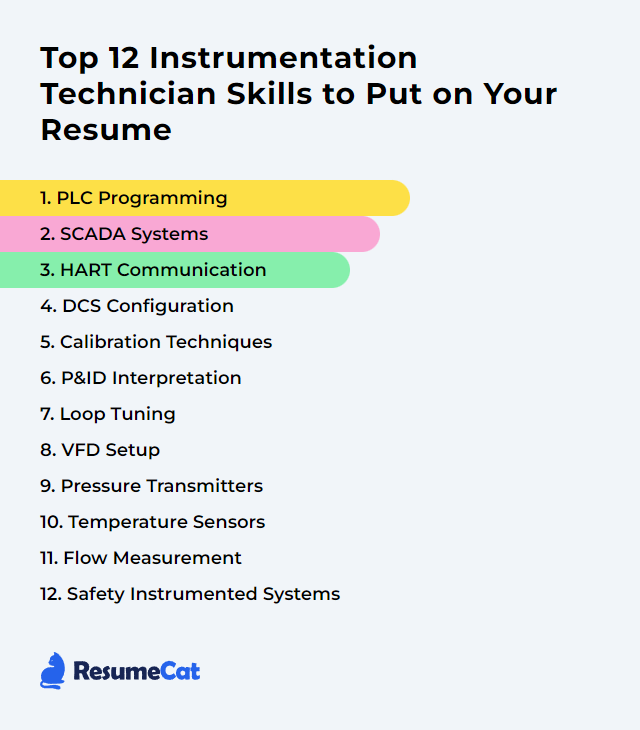Top 12 Instrumentation Technician Skills to Put on Your Resume
Aspiring to excel as an instrumentation technician demands a nimble blend of hands-on savvy, rigorous thinking, and a comfort with complex systems. Put those strengths into sharp words on a resume and hiring managers can see, quickly, that you can diagnose, configure, and keep high-stakes instrumentation humming without drama.
Instrumentation Technician Skills
- PLC Programming
- SCADA Systems
- HART Communication
- DCS Configuration
- Calibration Techniques
- P&ID Interpretation
- Loop Tuning
- VFD Setup
- Pressure Transmitters
- Temperature Sensors
- Flow Measurement
- Safety Instrumented Systems
1. PLC Programming
PLC programming means building and refining the control logic that runs on programmable logic controllers to drive machines, sequences, and interlocks. It covers everything from I/O mapping and task scheduling to fault handling, diagnostics, and network messaging—so production runs predictably, and troubleshooting stays swift.
Why It's Important
Strong PLC programming underpins safe, efficient automation. It reduces downtime, sharpens diagnostics, and turns process intent into consistent behavior at the controller level.
How to Improve PLC Programming Skills
Master IEC 61131-3 languages: Ladder, Function Block, Structured Text. Use the right tool for the job, not just the familiar one.
Adopt coding standards: Clear tag naming, modular routines, tight comments, version control, and change logs. Make handoffs painless.
Simulate before touching the plant: Emulators, test benches, and offline I/O forcing catch gremlins early.
Plan comms: Know your networks and protocols—EtherNet/IP, PROFINET, Modbus TCP. Map timeouts, retries, and diagnostics.
Engineer for safety and reliability: Fault states, watchdogs, permissives, bumpless transfers, redundancy checks.
Tune scan performance: Prioritize tasks, trim heavy routines, debounce inputs, and avoid unnecessary instructions in fast tasks.
Test like a skeptic: FAT/SAT scripts, edge cases, power cycles, comms loss, sensor failures, odd setpoints.
Harden: User roles, backups, signed firmware, segmented networks, and disciplined patching.
How to Display PLC Programming Skills on Your Resume
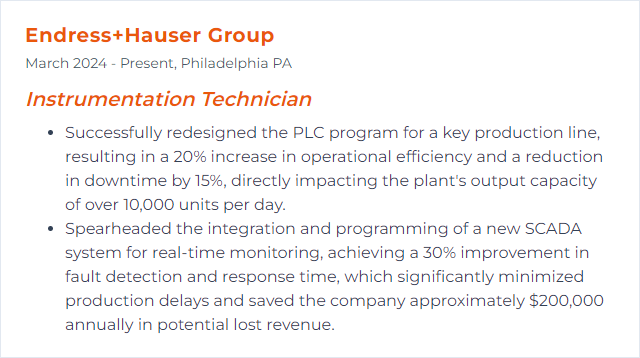
2. SCADA Systems
SCADA (Supervisory Control and Data Acquisition) systems collect live data from field devices, visualize it, alarm on it, and allow operators to steer processes from a central vantage point.
Why It's Important
SCADA ties the plant together—visibility, control, history, alarms, and reporting. When it’s well-designed, operations flow; when it’s not, noise and blind spots creep in.
How to Improve SCADA Systems Skills
Engineer resilient architecture: Redundant servers, historians, networks, and time sync (NTP/PTP) to keep data coherent.
Secure by design: Role-based access, network segmentation, least privilege, patch cadence, and tested backups.
Design pragmatic HMIs: High-contrast, alarm-focused, trend-rich screens that reduce cognitive load (avoid clutter, emphasize state).
Rationalize alarms: Clear priorities, deadbands, shelving rules, and KPIs for alarm floods.
Normalize data: Tag naming conventions, units, scaling, and metadata so trends and reports compare apples to apples.
Instrument diagnostics: Use health tags, heartbeat bits, and comms watchdogs to spotlight failures quickly.
Train and drill: Operator practice for abnormal situations, playbooks for failover, and restore procedures.
How to Display SCADA Systems Skills on Your Resume

3. HART Communication
HART (Highway Addressable Remote Transducer) overlays a digital signal on the 4–20 mA analog loop. Two-way chatter on the same wires—configuration, diagnostics, and process variables—without breaking the analog signal.
Why It's Important
It unlocks fast device setup and deep diagnostics, trims field time, and makes loop checks smarter while the process keeps running.
How to Improve HART Communication Skills
Mind loop integrity: Use shielded twisted pair, proper terminations, and good grounding to quash noise.
Set correct loop resistance: Ensure the loop presents adequate resistance for communication (commonly around 250 Ω) and avoid overloading supplies.
Keep firmware and DDs current: Update devices and handhelds so parameters render correctly.
Validate with the right tools: Communicator/modem, multimeter, and if needed an oscilloscope to spot signal distortion.
Manage multidrop prudently: Follow device limits (typically up to 15 devices), assign unique addresses, and document it.
Record everything: Tag IDs, ranges, damping, calibration dates—keep a clean asset history.
How to Display HART Communication Skills on Your Resume
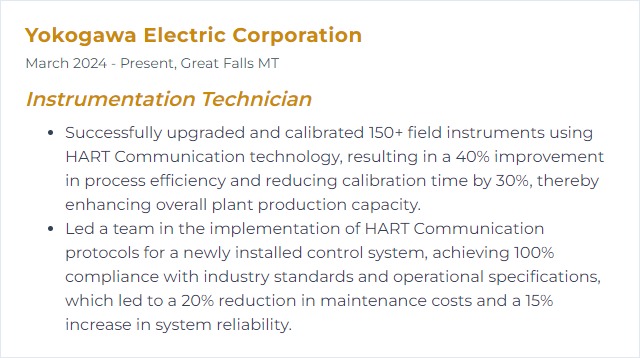
4. DCS Configuration
DCS (Distributed Control System) configuration stitches together controllers, I/O, networks, graphics, alarms, and recipes into one coherent control environment. It’s the blueprint and the wiring for how a plant thinks.
Why It's Important
Good configuration yields stability, fast recovery, and clear operations. Poor configuration breeds nuisance alarms, bottlenecks, and confusion.
How to Improve DCS Configuration Skills
Know the architecture: Controllers, I/O types, loading, scan times, redundancy roles—what talks to what and how fast.
Standardize: Libraries for loops, interlocks, and faceplates. Consistent naming and templates make scaling easy.
Engineer alarms: Follow an alarm philosophy (priorities, deadbands, shelving rules) and test against real scenarios.
Plan the network: Segmentation, time sync, QoS, and redundancy with clear diagnostics for failover events.
Patch with discipline: Validate in a sandbox, snapshot, then deploy with rollback plans and change records.
Back up everything: Automated backups, off-box copies, and periodic restore tests.
Document relentlessly: Control narratives, cause-and-effect, I/O lists, ranges, firmware, and setpoints—kept current.
How to Display DCS Configuration Skills on Your Resume
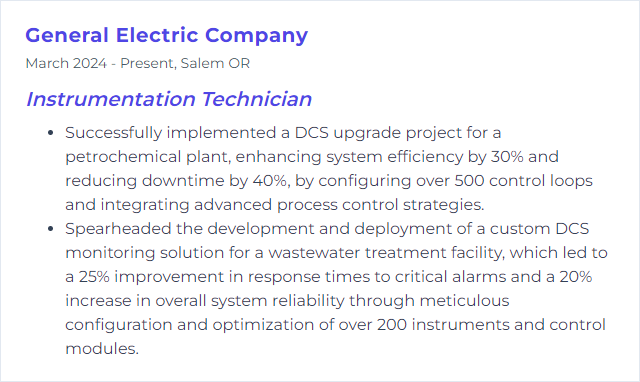
5. Calibration Techniques
Calibration aligns an instrument’s reading to a traceable standard and records the evidence. It’s about uncertainty, repeatability, and proving that the measurement can be trusted within specified limits.
Why It's Important
Accurate instruments keep processes safe and quality tight. Regulators, customers, and audits all depend on clean, defensible calibration data.
How to Improve Calibration Techniques Skills
Use traceable standards: Reference equipment with valid certificates and known uncertainties.
Control the environment: Temperature, humidity, vibration, and electrical noise can skew results—stabilize them.
Follow robust methods: Multi-point up/down checks, as-found/as-left, and acceptance criteria with guard-banding where needed.
Optimize intervals: Base periodicity on criticality and historical drift, not habit.
Record with rigor: Results, adjustments, serials, tech initials, and timestamps—traceability without gaps.
Verify tools: Routine cross-checks and interim checks for reference gear so surprises don’t linger.
Train for nuance: Pressure bleed rates, thermal soak times, line isolation—technique matters.
How to Display Calibration Techniques Skills on Your Resume

6. P&ID Interpretation
P&IDs (Piping and Instrumentation Diagrams) are the map: equipment, lines, instruments, and how they’re tied together. Reading them well means you can install, commission, and troubleshoot without guesswork.
Why It's Important
Clear interpretation prevents miswires, missed interlocks, and unsafe work. It’s the difference between efficient work and wandering.
How to Improve P&ID Interpretation Skills
Learn the symbology: ISA symbols, line types, valve failure positions, signal lines, and instrument functions.
Decode tag structures: Loop numbers, service codes, and modifiers so you can trace from drawing to device quickly.
Cross-reference: Match P&IDs to loop sheets, I/O lists, data sheets, and cause-and-effect.
Trace flows: Follow process paths, relief routes, and isolation points; mark-up for field reality.
Manage redlines: Keep as-builts accurate—capture changes during commissioning and maintenance.
How to Display P&ID Interpretation Skills on Your Resume
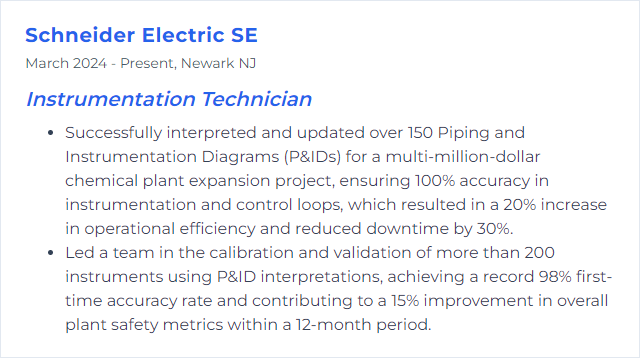
7. Loop Tuning
Loop tuning shapes how a control loop responds—fast but not jumpy, stable but not sluggish. PID terms (P, I, D) get tweaked so the process lands where it should.
Why It's Important
Good tuning cuts variability, boosts quality, and protects equipment. Bad tuning wastes energy and frays nerves.
How to Improve Loop Tuning Skills
Characterize the process: Step tests, open-loop responses, and noting deadtime and gain before touching gains.
Pick a method: Lambda/IMC for robustness, Ziegler–Nichols or Cohen–Coon for quick starts—then refine.
Respect deadtime: Add filters or lead/lag; don’t let D-term amplify noise.
Handle integrator windup: Enable anti-windup and output limits to avoid long recoveries.
Use structure: Cascade, feedforward, and setpoint weighting where they help.
Test at the edges: Different loads, setpoint jumps, disturbances—verify across the range.
Document: Record as-found, as-left, and the reasoning so the next adjustment is faster.
How to Display Loop Tuning Skills on Your Resume
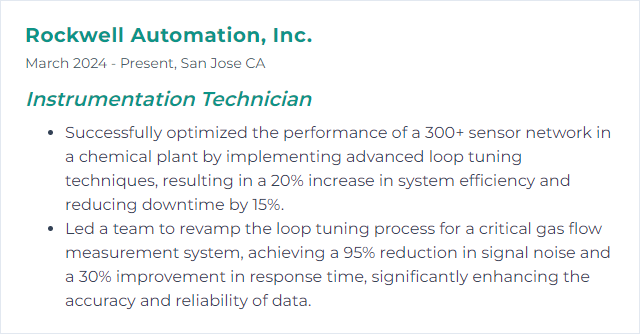
8. VFD Setup
VFDs (Variable Frequency Drives) command motor speed and torque by shaping voltage and frequency. Setup spans hardware installation, parameterization, and network/control integration.
Why It's Important
Proper setup trims energy use, softens mechanical wear, and gives tight process control—without nuisance trips.
How to Improve VFD Setup Skills
Start with the nameplate: Voltage, current, power, poles—enter motor data accurately.
Choose the control mode: V/Hz for simplicity, vector control for torque precision; autotune when available.
Shape the ramps: Accel/decel, S-curves, and current limits to protect the drive train.
Tame resonance: Skip frequencies to dodge mechanical resonant bands.
Mind the wiring: Shielded motor cables, proper grounding, and EMC filters to quiet emissions.
Protect the system: dV/dt or sine filters on long runs; line reactors or filters for harmonics.
Cool it: Clearance, airflow, and enclosure rating; dust and heat are silent killers.
Integrate cleanly: Map I/O, set comms (EtherNet/IP, Modbus, PROFINET), and verify interlocks and STO circuits.
How to Display VFD Setup Skills on Your Resume
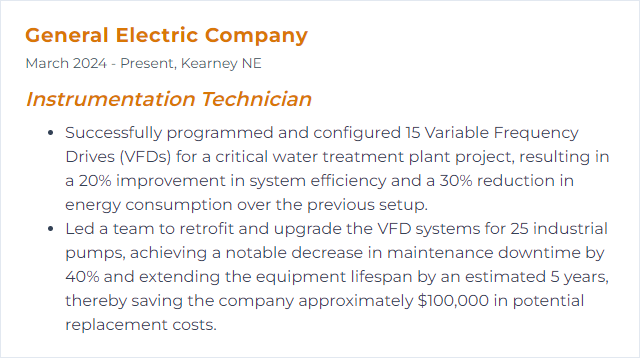
9. Pressure Transmitters
Pressure transmitters sense pressure—gauge, absolute, or differential—and turn it into a reliable electrical signal for control and monitoring.
Why It's Important
Accurate pressure data guards safety, improves efficiency, and anchors many control loops. Bad readings snowball into bad decisions.
How to Improve Pressure Transmitters Skills
Install with intention: Correct orientation, impulse line slope, isolation valves, and mounting to avoid plugs, gas pockets, or liquid traps.
Select smartly: Match range, overpressure rating, wetted materials, and diaphragm seals or capillaries to the service.
Calibrate and trim: Multi-point checks, zero/span or sensor trim, and damping tuned to the process dynamics.
Protect the measurement: Snubbers, heat tracing, fill fluids suited to temperature, and proper impulse line lengths.
Plan for maintenance: Leak checks, impulse line cleaning, gasket health, and documented proof tests.
Respect the area: Use devices with the right approvals for hazardous locations and verify grounding/bonding.
How to Display Pressure Transmitters Skills on Your Resume
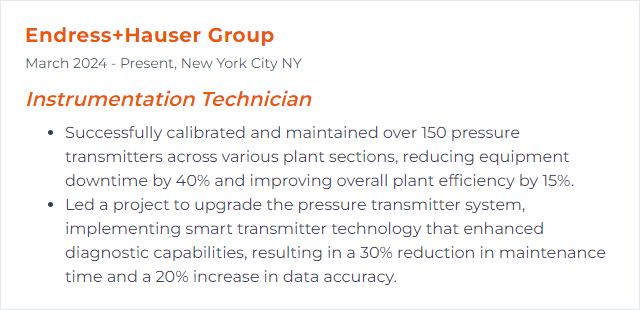
10. Temperature Sensors
Temperature sensors—thermocouples, RTDs, thermistors—convert thermal reality into signals a control system can use.
Why It's Important
Temperature touches quality, safety, and energy use. Good sensing prevents slow drift from turning into big waste.
How to Improve Temperature Sensors Skills
Pick the right type: RTDs for accuracy, thermocouples for high temperatures, thermistors for narrow-range sensitivity.
Wire wisely: 3- or 4-wire RTD circuits for lead compensation; proper cold-junction handling for thermocouples.
Install for truth: Correct immersion depth, good thermal contact, and well-designed thermowells checked for wake frequency.
Guard against noise: Shielding, grounding, and clean routing away from high-power cabling.
Calibrate and monitor drift: Periodic checks and replacements where high cycling accelerates aging.
Document location intent: Sensor placement relative to heat sources, flow, and mixing zones matters.
How to Display Temperature Sensors Skills on Your Resume

11. Flow Measurement
Flow measurement quantifies how much fluid moves. Technologies span differential pressure, Coriolis, mag, ultrasonic, vortex, turbine, and more—each with quirks.
Why It's Important
Inventory, custody transfer, control performance, energy balance—flow touches them all. If it’s wrong, everything downstream wobbles.
How to Improve Flow Measurement Skills
Select fit-for-purpose meters: Consider fluid phase, conductivity, viscosity, Reynolds number, temperature, and required accuracy.
Install to spec: Straight-run, orientation, grounding rings, flow conditioners, and proper tapping locations.
Compensate smartly: Temperature and pressure correction where density or viscosity swings matter.
Use diagnostics: Health indicators, signal strength, drive gain, zero stability—trust but verify.
Calibrate or verify: In-situ checks, prover runs where applicable, and zeroing with stable conditions.
Avoid two-phase surprises: Air entrainment, cavitation, flashing, and coating—design to prevent them.
How to Display Flow Measurement Skills on Your Resume

12. Safety Instrumented Systems
Safety Instrumented Systems (SIS) are the last line of defense—independent hardware/software functions that push a process to a safe state when hazards flare.
Why It's Important
People, equipment, environment. When abnormal conditions hit, SIS cuts risk to acceptable levels by acting fast and predictably.
How to Improve Safety Instrumented Systems Skills
Work the safety lifecycle: From hazard analysis and SIL determination to operation and decommissioning—documented and auditable.
Engineer independence: Keep SIS separate from basic control where required; avoid common-cause failures.
Select proven devices: Hardware with appropriate certifications and published failure data to meet target SIL.
Test with intent: Proof test intervals, partial-stroke testing, bypass management, and captured test coverage.
Guard configuration: Access control, change management, locked logic, and verified backups.
Audit and assess: Periodic functional safety assessments, cause-and-effect validation, and incident learnings fed back into the lifecycle.
How to Display Safety Instrumented Systems Skills on Your Resume

